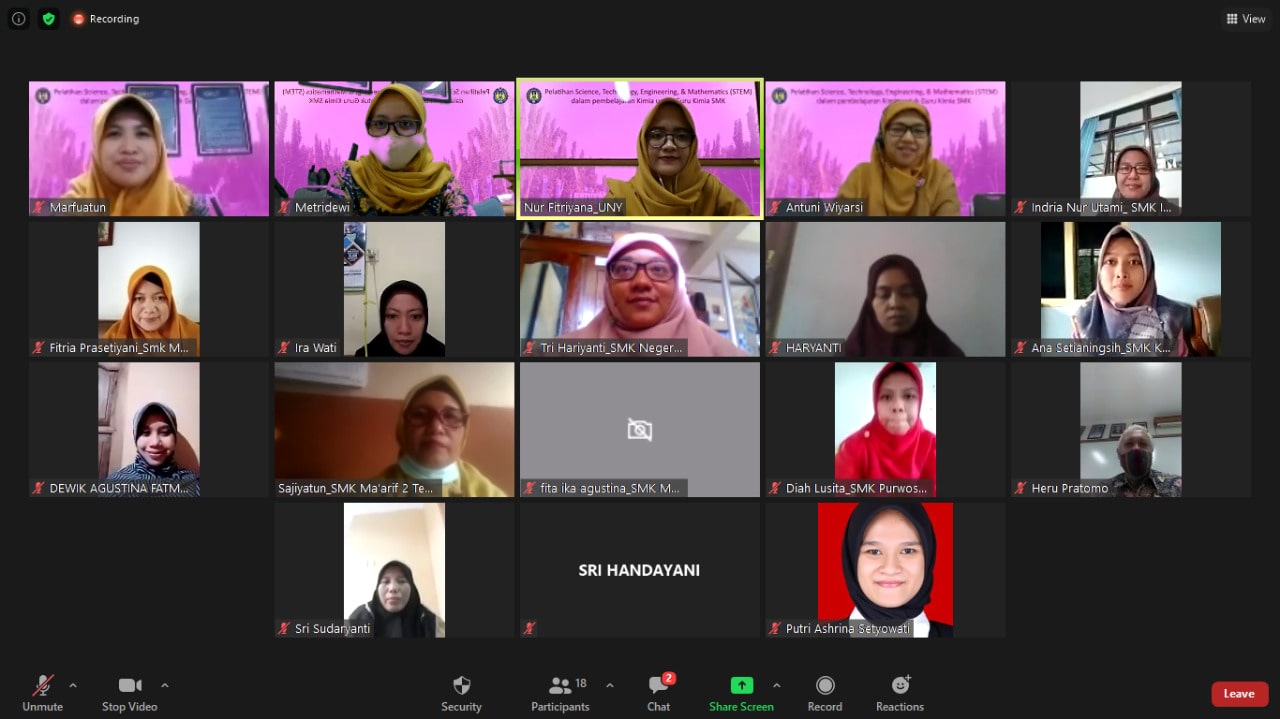 Bahasa Indonesia
Bahasa Indonesia English
English
You are here
STEM Learning Approach for Chemistry Teacher in Vocational Senior High School

One of the society-service programs (PPM) carried out by the Chemistry Education Study Program is the Development of STEM-based Chemistry Learning for Chemistry Teachers in Vocational Senior High School, that has been held on Friday 16 October 2020. This activity is an effort to improve the quality of chemistry learning. Total of 25 vocational school teachers from various fields of expertise has participated in this PPM activity.
The speech was started by Dr. Antuni Wiyarsi, M.Sc as a chief of PPM Program, continued withthe topic of basic concepts of STEM. Reform - The work demands that require the integration of components of Science Technology Engineering Mathematics (STEM) which were developed in America since 2000, then adopted by various countries. STEM integrates various scientific viewpoints. Why is STEM worth to developed in learning activities in Indonesia? In addition to literacy as an evaluation system in Indonesia later, learning with the STEM approach aims to prepare students to become qualified human resources for economic improvement. Meanwhile, STEAM is a development of STEM. The STEM learning approach started from Problem based Learning and became Project based Learning. STEM as integrated learning, supports 21st century skills such as Collaboration, problem solving and critical thinking.
The second topic was delivered by Bapak Heru Pratomo Al, M.Si, relating to the projects and applications of STEM in chemistry learning activities. How can the STEM learning approach be implemented in chemistry subjects, we need to design a lesson plan (RPP) with certain models such as Project based Learning with its syntax, combined with a STEM approach, that is in accordance with the areas of expertise of students in SMK. Of course, the evaluation system developed uses the STEM approach. Evaluation methed presented by Ibu Marfuatun, M.Si, the evaluation of STEM skills includes how different possible solutions to a problem are given to students. By combining materials and ideas in an intelligent and imaginative way to create problem solvinng, students are encouraged to design prototypes and testing the design, is it can solve a given problem? With hope, that students are able to evaluate the results of testing, analyzing and interpreting data, so that the students' ideas can be communicating in innovative ways.
Through this PPM activity, it is hoped that it can provide inspiration for vocational chemistry teachers to design STEM-approached learning such as projects or prototypes for chemistry teaching in vocational schools, so that students get real experiences about the materials they learn according to their competency skills.



Sistem Informasi
Kontak Kami
Program Studi Pendidikan Kimia
FMIPA Universitas Negeri Yogyakarta
Gedung Dekanat D.07 FMIPA UNY
Kampus Karangmalang Yogyakarta 55281
Telp. (0274)586168 Pes. 115
Email: pend_kimia@uny.ac.id
Copyright © 2024,
